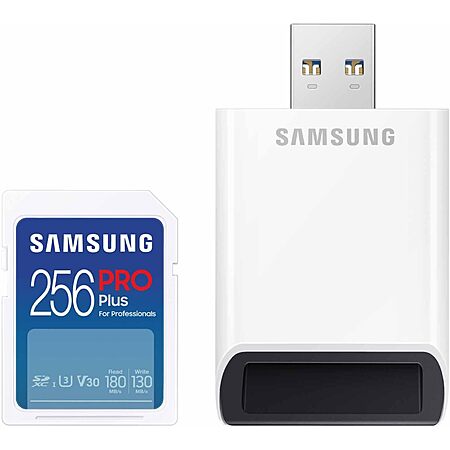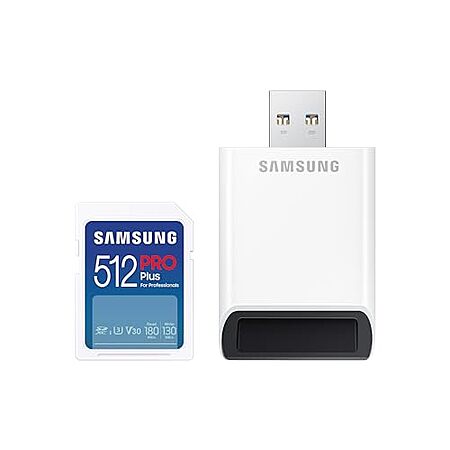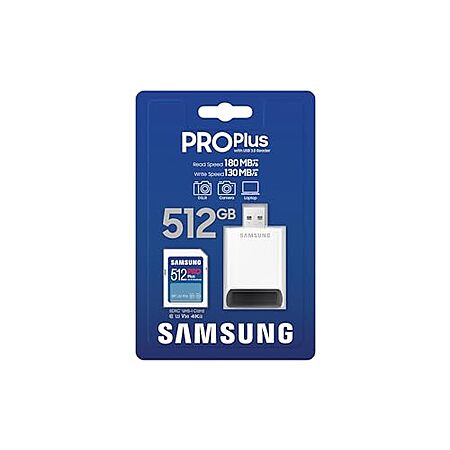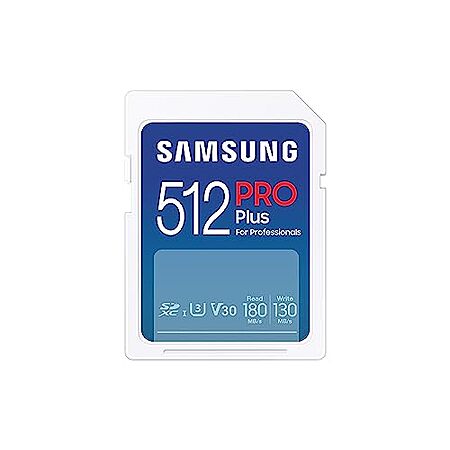expiredphoinix | Staff posted Nov 21, 2024 09:50 AM
Item 1 of 5
Item 1 of 5
expiredphoinix | Staff posted Nov 21, 2024 09:50 AM
$28: 512GB SAMSUNG PRO Plus Full Size SDXC Memory Card + Reader at Amazon
$18
$44
59% offAmazon
Visit AmazonGood Deal
Bad Deal
Save
Share





Leave a Comment
15 Comments
Sign up for a Slickdeals account to remove this ad.
Our community has rated this post as helpful. If you agree, why not thank iDroid
Full disclosure, I own one of those, and have replace all my card to UHS II.
Sign up for a Slickdeals account to remove this ad.
Full disclosure, I own one of those, and have replace all my card to UHS II.
Having said that, if your equipment supports UHS-II cards, absolutely go nuts.
Edit: in retrospect I suspect you meant 100MB/s not 100Mbps, in which case that's still not entirely accurate as the "ultimate" variant of the card in this listing tests faster than a fair number of UHS-ii SD cards, achieving 134MB/s and 181MB/s sequential write and read speeds, respectively. The "pro" is right behind it at 132MB/s and 181.
So clearly they're not unable to write above 100, especially not in the context of this listing.
BUT, historically speaking, UHS-i cards by and large have been far closer to what you describe than to what this and other higher end variants are capable of, and even at the speeds of this card and although it's faster than a fair number of UHS-ii cards, the bottom line is this is the most performant UHS-i card available whereas the fastest UHS-ii card available reliably write and read at 289MB/s & 306MB/s sequential, respectively so…
TLDR: anyone wanting the fastest possible SD card *who has a UHS-ii capable device (most are not) should go that route, if budget allows.
And we should all be hassling manufacturers to move onto faster and higher quality NAND flash cards that at minimum approach CFexpress Card speeds
Having said that, if your equipment supports UHS-II cards, absolutely go nuts.
UHS1 standard set the maximum transfer speed of...104MB/s. you CANNOT go above the UHS1 speed limit without becoming proprietary, such as what most are doing here with the included card adapter that is not USH1 standard, in order to go faster than 104MB/s.
so here is the proposition: you really only got that speed with a special card adapter, which really just limit to compute use with USB adapters. but just about any USB3 thumb drive is cheaper and faster. if you use it for anything that is UHS1 standard like camera , you won't got anywhere near the 180/200MBps. thus was my question
UHS1 standard set the maximum transfer speed of...104MB/s. you CANNOT go above the UHS1 speed limit without becoming proprietary, such as what most are doing here with the included card adapter that is not USH1 standard, in order to go faster than 104MB/s.
so here is the proposition: you really only got that speed with a special card adapter, which really just limit to compute use with USB adapters. but just about any USB3 thumb drive is cheaper and faster. if you use it for anything that is UHS1 standard like camera , you won't got anywhere near the 180/200MBps. thus was my question
We're getting a bit into the weeds here but Let's take what you said as gospel and assume a 104MB/s maximum for UHS-i cards.
The point is that at a minimum the cards from this listing will saturate that bus as read and write at 100MB/s without issue.
It's not worth getting into the specifics of how higher than the defined UHS-I BUS speeds are reached, but the bottom line is adjusting BUS & clock timings as done via SanDisk QuickFlow has long since been adopted into subsequent SD Association Standard Revisions 4.0 thru 9.0+ , which is why you can take the card from this listing and get 180MB/s read speed from a prograde usb c reader without any issue or third party drivers etc.
That said, the most important thing is just that it will without issue read and write at 100MB/s unlike the old school cards that advertised ~100MB/s anybut could only hit half that under the best of conditions
And you're right you're right for any device that literally needs 100MB/s + sequential write speeds…do your due diligence …but I don't know if there's any such devices that are limited to only a UHS-i slot
And any device that has a uhs-ii BUS has those cards available to them so It seems a bit of a moot point
wait until people find out they're still planning to release UHS-iii (3!) for some silly reason
UHS1 standard set the maximum transfer speed of...104MB/s. you CANNOT go above the UHS1 speed limit without becoming proprietary, such as what most are doing here with the included card adapter that is not USH1 standard, in order to go faster than 104MB/s.
so here is the proposition: you really only got that speed with a special card adapter, which really just limit to compute use with USB adapters. but just about any USB3 thumb drive is cheaper and faster. if you use it for anything that is UHS1 standard like camera , you won't got anywhere near the 180/200MBps. thus was my question
but again let's ignore all speed above 104MB/s for the sake of argument, as it's not necessary to explain where people are finding value here.
That handles 4K60 HDR video from the majority of consumer devices, the vast majority of which only require 30MB/s, which I'll note is well less than the half of 100MB/s you derided these UHS-i cards for often being limited to.
This card and cards like it will therefore not just handle the highest bitrate video from most action cams and consumer oriented APS-C mirrorless cameras
But it will allow you to transfer your files to a pc or Mac at up to ~180MB/s (that's not a claimed speed that's the speed achieved on a 3rd party card reader by a testing site)
So …thumb drives are obviously useless in this context, people are buying this for cameras.
The worst part of slow sd cards for consumers is the file offload process, cards like this allow you to do that as fast as is physically possible for UHS-I cards
TLDR: That's it. That's the simple answer. That's why it exists. That's why people use it. To get the best possible performance out of uhs-I devices, well above 3x the speed you speed you noted were often the norm for uhs-I cards
uhs-ii and CFexpress are great, but many of us have devices we want the best experience from that aren't uhs-ii
If you're actually going to use it for your camera though, then it makes sense
Sign up for a Slickdeals account to remove this ad.
If you're actually going to use it for your camera though, then it makes sense
Leave a Comment